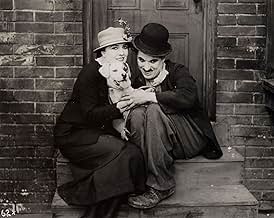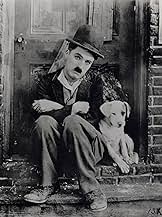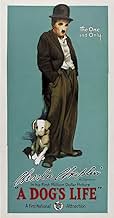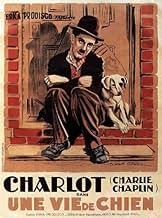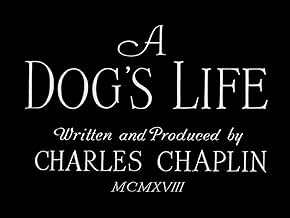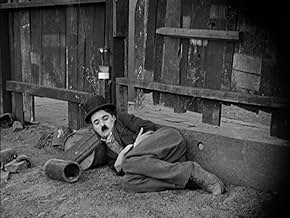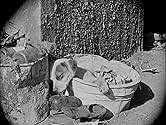PUNTUACIÓN EN IMDb
7,6/10
10 mil
TU PUNTUACIÓN
Añade un argumento en tu idiomaThe Little Tramp and his dog companion struggle to survive in the inner city.The Little Tramp and his dog companion struggle to survive in the inner city.The Little Tramp and his dog companion struggle to survive in the inner city.
- Dirección
- Guión
- Reparto principal
Edna Purviance
- Bar Singer
- (sin acreditar)
Dave Anderson
- Bartender
- (sin acreditar)
Bert Appling
- Unemployed Man
- (sin acreditar)
Albert Austin
- Crook
- (sin acreditar)
Henry Bergman
- Fat Unemployed Man
- (sin acreditar)
- …
Alva D. Blake
- Man in Dance Hall
- (sin acreditar)
Mel Brown
- Employment Agency Clerk
- (sin acreditar)
- …
Minnie Chaplin
- Dance-Hall Dramatic Lady
- (sin acreditar)
Syd Chaplin
- Lunchwagon Owner
- (sin acreditar)
Dorothy Cleveland
- Woman in Dance Hall
- (sin acreditar)
Slim Cole
- Unemployed Man
- (sin acreditar)
Margaret Cullington
- Woman in Dance Hall
- (sin acreditar)
Billy Dill
- Man in Dance Hall
- (sin acreditar)
Margaret Dracup
- Woman in Dance Hall
- (sin acreditar)
Jack Duffy
- Man in Dance Hall
- (sin acreditar)
Robert Dunbar
- Old Man in Dance Hall
- (sin acreditar)
Ella Eckhardt
- Woman in Dance Hall
- (sin acreditar)
Reseñas destacadas
This is an entertaining comedy with a couple of particularly amusing scenes. Chaplin is joined by several of his regular supporting players like Edna Purviance and Henry Bergman, plus Syd Chaplin, and the cast works together well. The story is funny, yet not without some substance either.
As his usual 'tramp' character, Charlie is already living "A Dog's Life" when he befriends a stray dog, and they share some adventures together. Chaplin hits a good balance in keeping himself and the dog sympathetic without overdoing the sentiment. There are some slow stretches that keep it from being even better, but the good parts make up for them and make this definitely worth watching. One particular highlight is a scene where Charlie tries to outwit two thieves - it's very cleverly done and very funny.
Anyone who likes Chaplin's comedies should enjoy this one. It has good comedy, a talented and familiar cast, and some worthwhile material - just about everything you would expect in one of Chaplin's features.
As his usual 'tramp' character, Charlie is already living "A Dog's Life" when he befriends a stray dog, and they share some adventures together. Chaplin hits a good balance in keeping himself and the dog sympathetic without overdoing the sentiment. There are some slow stretches that keep it from being even better, but the good parts make up for them and make this definitely worth watching. One particular highlight is a scene where Charlie tries to outwit two thieves - it's very cleverly done and very funny.
Anyone who likes Chaplin's comedies should enjoy this one. It has good comedy, a talented and familiar cast, and some worthwhile material - just about everything you would expect in one of Chaplin's features.
This film was one of three that were later combined by Chapin into a compilation that was released to theaters in the late 1950s under the title "The Chaplin Review".
Of the three films combined for The Chapline Review, this is probably the most familiar in style and, to me, the least interesting. While it is STILL a very good film, it just didn't seem all that new or different. We have the Little Tramp down on his luck and looking to feed himself when he stumbles upon a poor lonely dog being picked on by the other dogs. So, he adopts it and they both set out on some adventures. I know this may sound strange, but to me this film felt a lot like an earlier incarnation of THE KID--though of course in this case it's a cute mutt and not Jackie Coogan. A very good and entertaining short with no serious flaws.
Of the three films combined for The Chapline Review, this is probably the most familiar in style and, to me, the least interesting. While it is STILL a very good film, it just didn't seem all that new or different. We have the Little Tramp down on his luck and looking to feed himself when he stumbles upon a poor lonely dog being picked on by the other dogs. So, he adopts it and they both set out on some adventures. I know this may sound strange, but to me this film felt a lot like an earlier incarnation of THE KID--though of course in this case it's a cute mutt and not Jackie Coogan. A very good and entertaining short with no serious flaws.
This was Charlie Chaplin's first film for First National, and with his pictures there, he could create movies of longer, or varied, length, rather than the two-reelers he was obliged to churn out before. His Mutual shorts were a vast improvement over his previous work, but watching them I'd sometimes get the sense that his ideas required more time to elaborate, to fully realize, or unfold. The hilarity of the gags in "A Dog's Life" result from this newly acquired freedom to expand his films.
I don't think it's one of Chaplin's most important works, or one of his best, but "A Dog's Life" is very funny and left me in high spirits. The crying set piece was hilarious. As well, Chaplin continued to use props and settings to his comedic advantage, such as with the missing boards and the door of his fenced home when he eludes a policeman in the beginning of the film.
Perhaps, the most interesting aspect of this one is the elaborate pantomime that goes on. The creation of the world within a silent film often created problems for lesser filmmakers on what the role of sound is within that world. There is obviously sound in the world of "A Dog's Life", but the tramp continually ignores it and oft prefers to use pantomime to express himself--or others, as in the elaborate scene using his hands. This demonstrated a lot of thought on Chaplin's part, and it's something that could be done only in the silent era. For all the comic genius in America at the time, the fact that the clowns couldn't talk shouldn't be overlooked, for it was full of advantages.
I don't think it's one of Chaplin's most important works, or one of his best, but "A Dog's Life" is very funny and left me in high spirits. The crying set piece was hilarious. As well, Chaplin continued to use props and settings to his comedic advantage, such as with the missing boards and the door of his fenced home when he eludes a policeman in the beginning of the film.
Perhaps, the most interesting aspect of this one is the elaborate pantomime that goes on. The creation of the world within a silent film often created problems for lesser filmmakers on what the role of sound is within that world. There is obviously sound in the world of "A Dog's Life", but the tramp continually ignores it and oft prefers to use pantomime to express himself--or others, as in the elaborate scene using his hands. This demonstrated a lot of thought on Chaplin's part, and it's something that could be done only in the silent era. For all the comic genius in America at the time, the fact that the clowns couldn't talk shouldn't be overlooked, for it was full of advantages.
Played as a double feature, A Dog's Life is the short comedy that played with one of Chaplin's famous and most adored comedies The Kid. Set in the same atmosphere of the depressing ghettos of 1918, The Tramp becomes friends with a stray dog. A lost soul much like himself, the Tramp and the tramp become friends and become a team. After finding a stolen loot, the two work together to re-take the money they found. The ending is cute and nothing more. For a short, it does the trick of making the audience laugh. The title indicated that this is the story of the dog, when in fact, the Dog is the Tramp! Both are homeless and without love in their lives. By the end of the movie, they both end up finding true love and end up living a better life, together.
In 'A Dog's Life' our little tramp takes care of dog, the nice touch in this movie. Other things are familiar. He encounters the police, he tries to steal food from a salesman, has money problems in a bar, has some trouble with two thugs and of course he gets the girl.
The best single moment in this short is when he pretends to be one of the two thugs. With perfect timing this a perfect piece of comedy and just this part makes the movie worth watching. There are other funny moments, especially with the dog's tale. A nice short that is a little too long. The very funny final moments (including the part with the two thugs) make sure we don't think about that too much.
The best single moment in this short is when he pretends to be one of the two thugs. With perfect timing this a perfect piece of comedy and just this part makes the movie worth watching. There are other funny moments, especially with the dog's tale. A nice short that is a little too long. The very funny final moments (including the part with the two thugs) make sure we don't think about that too much.
¿Sabías que...?
- CuriosidadesThis was Charles Chaplin's first film for First National Pictures under a $1M contract where Chaplin had full creative control over his films for the first time.
- PifiasDuring the fight at the lunch cart, one of the props holding up the awning gets knocked away. In subsequent shots, the prop is back in place.
- Citas
Title Card: When dreams come true.
- ConexionesEdited into La revista de Chaplin (1959)
Selecciones populares
Inicia sesión para calificar y añadir a tu lista para recibir recomendaciones personalizadas
Detalles
- Duración33 minutos
- Color
- Mezcla de sonido
- Relación de aspecto
- 1.33 : 1
Contribuir a esta página
Sugerir un cambio o añadir el contenido que falta

